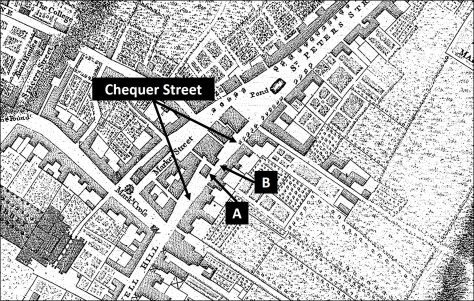The problem – the Red House pub
Today, when you walk out of the Maltings shopping centre onto Chequer Street, you generally encounter two rows of stationary or slow-moving traffic. In contrast, if you had stood on the same spot two hundred years ago, you would have been looking through th
e windows of two houses. During the eighteenth century and well into the next these buildings obstructed through traffic to the extent that, as Thomas Weedon Kent recalled in 1896, “… there was only room for one wagon to pass … If our casements were left open I recollect the wagons often used to break them.” (ref1) So narrow was the gap that it is thought that carriages and wagons instead used the High Street and Market Place to move between Holywell Hill and St Peter’s Street.
One of these buildings was the Red House (marked ‘A’ on the map), built sometime in the late 1600s (ref2) and bought in 1781 by the Kinder brewing family (ref3). It is no surprise then that, by the early 1800s, the Red House was an alehouse. Skelton’s Charity owned the freehold to the other building (marked ‘B’), the rent from which went to meet the charity’s key object of providing the “number of 26 penny loaves of bread” to the poor of the Abbey parish.
The impetus for change – Verulam Road
The year 1826 was important for the development of the road network in St Albans. In early Spring, at great cost, the Verulam Road was completed by-passing the notorious George Street hill as well as the meandering medieval road heading north-west from the town along Fishpool Street and through St Michaels. This work was carried out under the auspices of the St Albans Turnpike Trust.
The solution
Less well known is that, just a few months later, the Reading and Hatfield Turnpike Trust, which had bought the freeholds to the two buildings, demolished them making Chequer Street fully accessible to through traffic. By the end of the year, the town centre road network that we have inherited was largely complete.

Reading and Hatfield Road Trust obelisk, Marlow
Skelton’s Charity received £500 for its freehold (ref4), a sum that caused problems for its trustees as they now had too much money to cover the weekly bread dole. To make use of this surplus, the trustees obtained an order from the Court of Chancery içn 1839 to vary the objects to include a donation of coats, cloaks and blankets to the Abbey parish poor each November (ref5).
How much the Kinder family received for the Red House is not known but it is likely to have been at least equal to the £500 thecharity received. It may no be coincidence that, a year or so later, the family invested what must have been a large sum of money rebuilding the medieval inn, the Chequer on Chequer Street, as a modern 1820s hotel on what was now a through road. It opened in 1826. One of the first tenants was the colourful Thomas Coleman. Under his management it was renamed the ‘Turf Hotel’ and became famous in the 1830s as a centre for steeple-chasing.
References
- Herts Advertiser, 25 April 1896
- St Albans 1650-1700, A thoroughfare town and its people, J T Smith & M A North editors (Hertfordshire Publications, 2003), pg 22
- Bedfordshire County Record Office, Whitbread collection, WB/B4/1/Lu/Bell17
- Herts Archives & Local Studies, Sparrows Herne Turnpike Trust collection, TP4/130
- St Albans Abbey Muniment Room, Frank Kilvington’s notes on the Abbey’s charities





